(click here for the previous interview)
A painting like a world
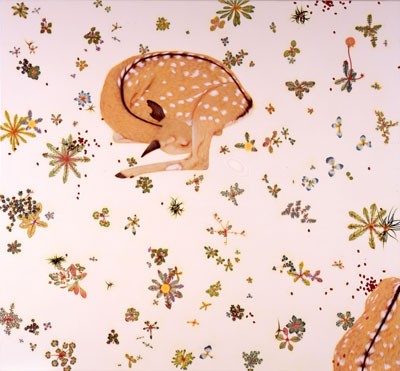
Dragon’s Back 2007 oil on canvas mounted on wood panel
ⓒMasako Ando Courtesy of Tomio Koyama Gallery
Tsubouchi:
I can imagine how fussy the voice of your pictures can be. How do you come up with your subject matter? You mentioned having lot of seeds that grow into a thick growth. But in the beginning, what interests you the most?
Ando:
I am interested in all things. These things elicit many kinds of feelings in me, which are scattered in my mind.
I suppose it’s the same for everyone.
Things that happened this morning. Words that I recall. Things that I read in the paper.
The white of the milk, the straight line of the chopstick, the expressions my family makes, or snippets of conversation, photos or letters stuck to the refrigerator door.
The things that humans do.
Synchronized swimming makes me laugh.
Why do people do such strange things? Things like the growing business of freeze-drying your pets after they have died. Lonely people. The cheerful sound of the words “freeze dry.” Knitted woolen socks for chair legs. The look of manicured dogs and fields. Dreams, poems, novels, songs. Then there’s war and torture.
Things that nature does The wonderful shapes of plants and animals, their beauty and grace.
Natural disasters. Catastrophes.
And so on.
Commingling various events and feelings. Borrowing the shapes of various motifs.
Bringing them together in one tight form. It is such a heavenly feeling!
Beautifully strange, unemotionally humorous.
Abstract, yet concrete. A picture that resembles the world. This is what I want to make, and I break my back and wrack my brains doing it.
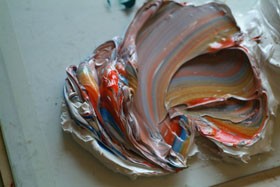
Wanting to stand clear
Tsubouchi:
Motifs seem to arise from each word that you speak. I guess each of your pictures is the “world” that you are feeling at the time. I wonder if they are inseparable—your dazzling technique and the way you create your “worlds”? In the end, by polishing the surface of your pictures so smoothly, you seem to encapsulate those worlds within enamel or highly luminous liquid crystal. How do you feel about this?
Ando:
Well.
I don’t intentionally try to make the surface so smooth. I do it because a smooth surface is easier to draw on. For the sake of the feel.
It’s the same for drawings. I use a Japanese paper called “matto sandasu,” a slightly yellowish paper. I use the back side to draw on because it’s smoother than the front.
If I’m not careful, a picture can quickly become gloomy, inward-looking and rather unpleasant. If the surface is rough, its character becomes immediately obvious.
All of this can easily happen with a motif, a facial expression, or a combination of both. When it does, I want to escape from that. To stand clear of it.
As I was answering your question, I made a discovery. That is, the content of what I paint and the texture that I create come from the same place within me, within my intuition.
It’s like having different Japanese names for the same part of the chicken—mune and seseri—both refer to meat in the breast area. Of course, this is probably an obvious point.
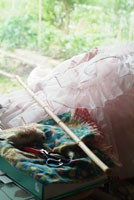
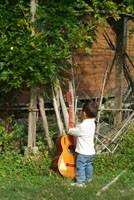
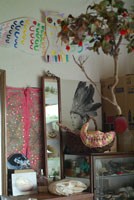
(Snapshots taken by the artist)
————————————————-
Hara Museum of Contemporary Art
Hara Documents 9: Masako Ando – The Garden of Belly Button
July 12 (Thursday) – August 19 (Sunday), 2012
